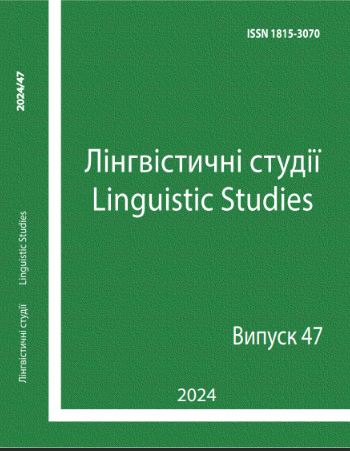Амбівалентність як критерій крос-культурної специфіки емоційних концептів: дані англійськомовного й німецькомовного веб-корпусів
DOI:
https://doi.org/10.31558/1815-3070.2024.47.1Ключові слова:
емоційний концепт, культурний концепт, лінгвокультура, амбівалентність, еквівалентність, оцінка, мовний корпусАнотація
У статті за допомогою опрацьованої корпуснобазованої методики з’ясовано, що амбівалентність може бути одним із критеріїв визначення крос-культурної специфіки емоційних концептів (ЕК). Апробація методики здійснена на прикладі ЕК англосакс. JOY – нім. FREUDE і англосакс. SADNESS – нім. TRAUER, які репрезентують базові емоції радості та смутку. Залучення емпіричних даних веб-корпусів дало змогу верифікувати тезу, що позитивний JOY містить більше негативних смислів, ніж FREUDE, а негативний SADNESS, навпаки, частіше трактується позитивно, ніж TRAUER. Прикметно, що визначення показників оцінки найрелевантніших 20-ти концептних проксиматів смислової структури ЕК JOY – FREUDE і SADNESS – TRAUER не підтвердило цю тезу, оскільки отримані результати є дещо протилежними.
Посилання
Bamberg, M., Ammirati, D., Shea, S. “What constitutes ‘good’ data for the study of language development? How children learn to talk about things with noname: 'double emotions'”. [V:] P.W. Davis (ed.), Alternative Linguistics. Descriptive and Theoretical Modes. Amsterdam: John Benjamins Publishing, 1995: 1–44.
Bradley, M.M., Lang, P.J. Affective norms for English words (ANEW): Instruction manual and affective ratings. Technical Report C-1, The Center for Research in Psychophysiology, University of Florida, 1999.
Doyle, C.M., Gendron, M., Lindquist, K.A. “Language is a unique context for emotion perception”. [V:] Affective Science 2/2, 2021: 171–177.
Fronhofer, N.-M. Emotion Concepts in Context: A Contrastive Analysis of English and German Discourse. Doctoral thesis for a doctoral degree (Applied Linguistics English). University of Augsburg, 2019.
Goddard, C. “Vocabulary of emotions and its development in English, German and other languages”. [V:] G.L. Schiewer, J. Altarriba, B.C. Ng (eds.), Handbook of Language and Emotion (HSK Handbooks series). Mouton de Gruyter, 2018: 1–18.
Hershfield, H.E., Scheibe, S., Sims, T.L., Carstensen, L.L. “When feeling bad can be good”. [V:] Social Psychological and Personality Science 4/1, 2013: 54–61.
Holm, O., Greaker, E., Strömberg, A. “Experiences of longing in Norwegian and Swedish 4- and 5-year-old children”. [V:] The Journal of Psychology 136/6, 2002: 608–612.
Kövecses, Z. Emotion concepts. New York: Springer, 1990.
McEnery, T., Wilson, A. Corpus linguistics. Edinburgh: Edinburgh University Press, 2001.
Mizin, K., Petrov, O. “Metaphorical modelling of cognitive structure of the concept STINGINESS in British, German, Ukrainian and Russian linguocultures”. [In:] Przegląd Wschodnioeuropejski VIІІ/1, 2017: 219–226.
Mizin, K., Petrov, O. “Emotional state GEMÜTLICHKEIT in cross-cultural perspective: Corpus-based approach”. [V:] Studies about Languages / Kalbų studijos 38, 2021: 43–60.
Mizin, K., Slavova, L., Khmara, V. “The equivalence of terms denoting the emotion concepts of Ger. ANGST and A.-S. FEAR: A corpusbased method”. [V:] Lege artis 6/2, 2021: 69–104.
Mizin, K., Slavova, L., Petrov, O., Yumrukuz, A. “Organizing the Germans’ emotional world through the prism of the opposition ORDNUNG vs. CHAOS: Ambivalent emotion concepts”. [In:] Amazonia Investiga 12/61, 2023: 224–235.
Moss, S.A., Couchman, G. “The conflict between the interventions that prevent burnout and the culture of modern capitalism: The benefits of ambivalent emotions”. [V:] The Australian and New Zealand Journal of Organisational Psychology 5, 2012: 13–24.
Moss, S.A., Wilson, S.G. “Ambivalent emotional states: The underlying source of all creativity?” [V:] The International Journal of Creativity and Problem Solving 24/2, 2014: 75–100.
Ogarkova, A. “Folk emotion concepts: Lexicalization of emotional experiences across languages and cultures”. [V:] K. Scherer, J. Fontaine, C. Soriano (eds.), Components of emotional meaning: A sourcebook. Oxford: Oxford University Press, 2013: 46–62.
Soriano, C. “Emotion and conceptual metaphor”. [V:] H. Flam, J. Kleres (eds.), Methods of Exploring Emotions. New York, London: Routledge, 2015: 206–214.
Rees, L., Rothman, N.B., Lehavy, R., Sanchez-Burks, J. “The ambivalent mind can be a wise mind: Emotional ambivalence increases judgment accuracy”. [V:] Journal of Experimental Social Psychology 49/3, 2013: 360–367.
Russell, J.A. “Culture and the categorization of emotions”. [V:] Psychological bulletin 110/3, 1991: 426–450.
Stamenov, M.I. “Ambivalence as a dialogic frame of emotions in conflict”. [V:] E. Weigand (ed.), Emotion in Dialogic Interaction. Amsterdam: John Benjamins Publishing, 2004: 183–204.
Tissari, H., Vanhatalo, U., Siiroinen, M. “From corpus-assisted to corpus-driven NSM explications: The case of Finnish viha (anger, hate)”. [V:] Lege artis 4/1, 2019: 290–334.
Underhill, J.W. Ethnolinguistics and cultural concepts: Truth, love, hate and war. Cambridge: Cambridge University Press, 2015.
Wierzbicka, A. Emotions Across Languages and Cultures: Diversity and Universals. Cambridge: Cambridge University Press, 1999.
Wilson, P., Lewandowska-Tomaszczyk, B. “Pride in British English and Polish: A cultural linguistics perspective”. [V:] F. Sharifian (ed.), Advances in Cultural Linguistics. Singapore: Springer, 2017: 373–409.


